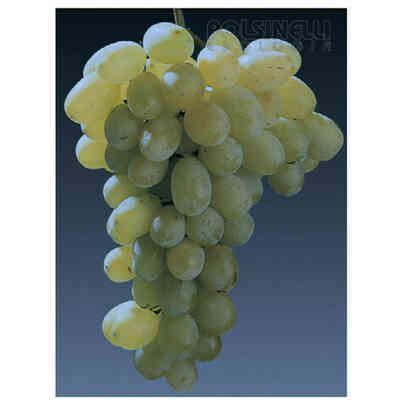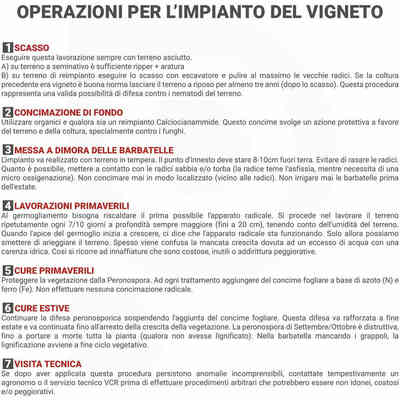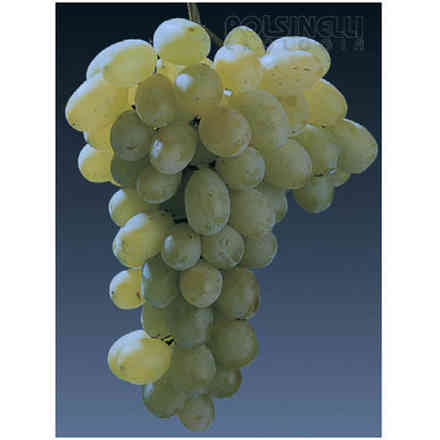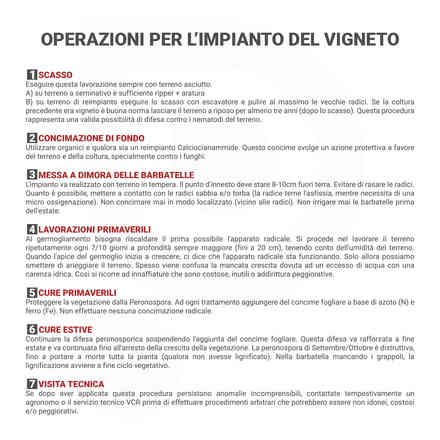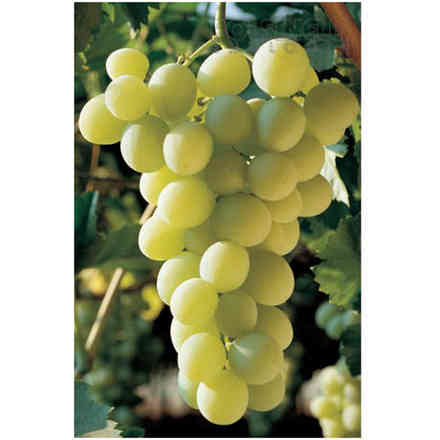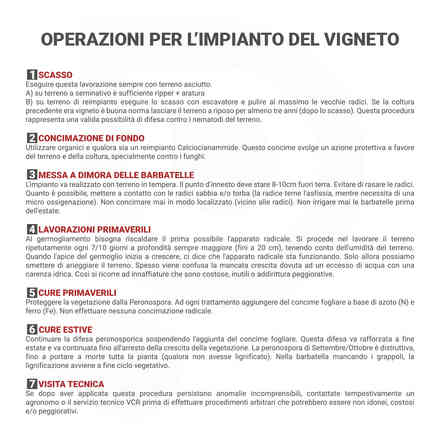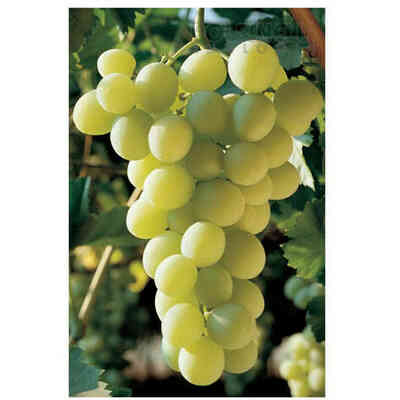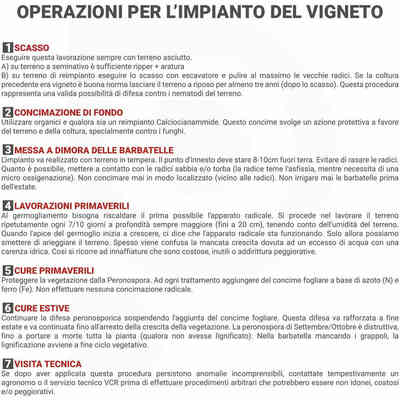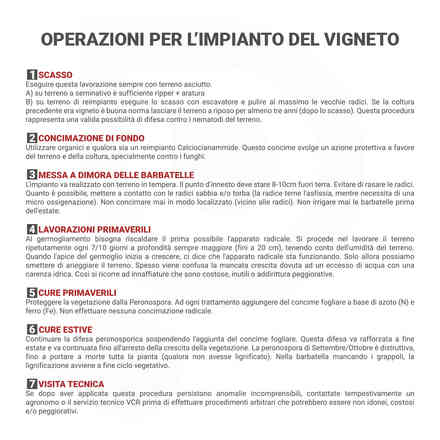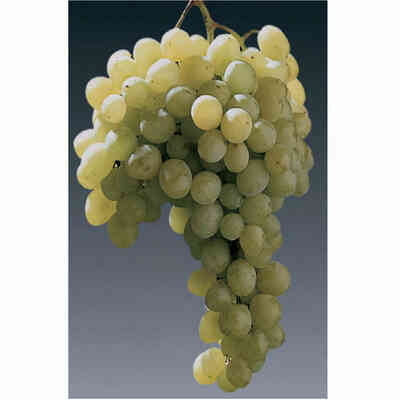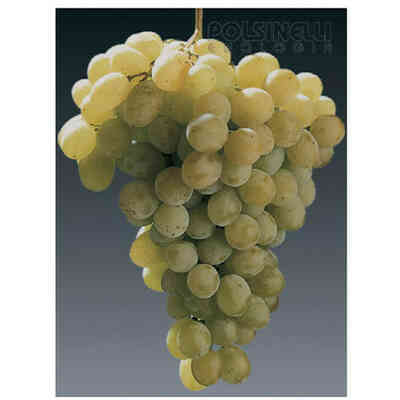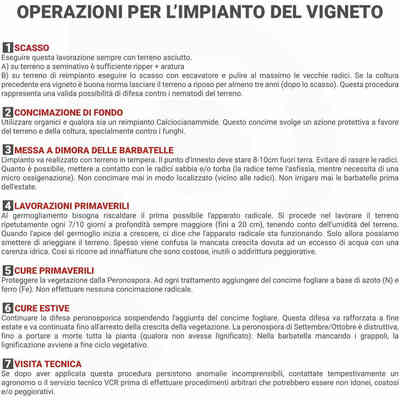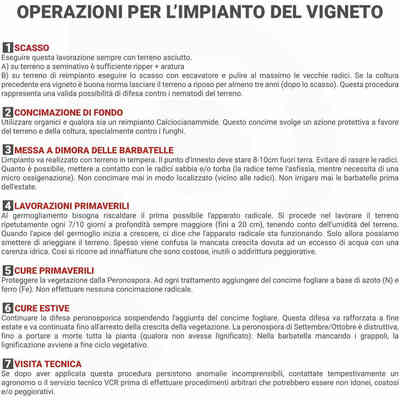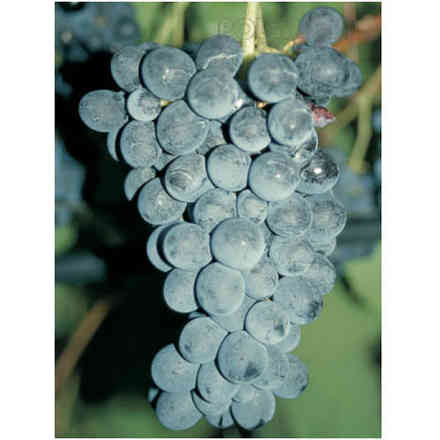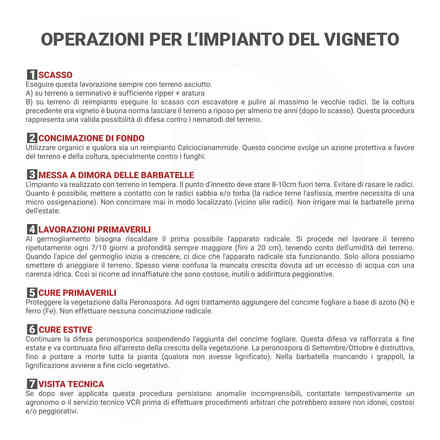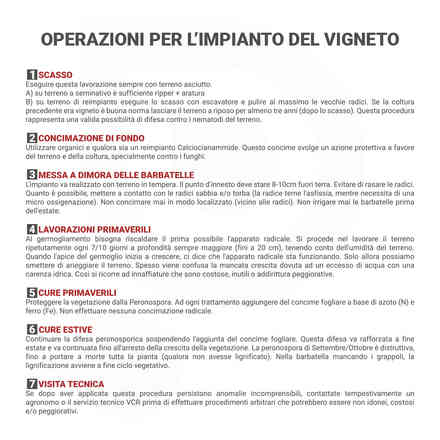Pizzutello Bianco (100 pieces)
Description
 AUTHORIZED RETAILER
AUTHORIZED RETAILER
PIZZUTELLO BIANCO (100 pieces)
Graft carrier 1103P - K5BB - S04 - 140RU - 420A (We will send the graft carrier available at the moment)
This is an old variety also found in Spain and France. It ripens in the third period. The bunches are medium-large, cylindrical-conical or pyramidal, fairly sparse, weighing 300-400 g. The grapes are medium-large, cylindrical-conical or pyramidal. The berry is medium-large, weighing 5-6 g, elongated and slightly curved; the skin is pruinose and thin; the flesh is crunchy. It keeps well on the plant and has good resistance to transport.
Ampelographic characteristics:
- Bud: 10 - 12 cm
Apex: expanded, arachnoid, light green-yellowish.
Apical leaves (1st to 3rd): the first two folded, the third unfolded; the first is tomentose or whitish above, the second is less tomentose and yellowish-green, the third is almost glabrous; the tomentum is softer, arachnoid below.
Basal leaves (from 4th onwards): spreading, glabrous; green.
Sprout axis: erect, tending to curve at the apex; pale green; glabrous.
- Sprout at flowering:
Apex: expanded, pubescent by sparse bristles; yellowish green.
Apex leaves: first one folded to the eaves, the other two unfolded; bristle-like to slightly velvety on the upper side, glabrous below; tri-pentalobed with a fairly obvious lobation; green with slight bronze tones; translucent surface.
Basal leaves: spreading, glabrous, pale green.
Sprout axis: tends to be pasterny, green, glabrous.
- Herbaceous shoot: elliptical in cross-section, outline almost smooth, glabrous, pale green with slight bronze shades towards the base.
- Tendrils: bifid or trifid, long, green.
- Inflorescence: small to medium, cylindrical, sometimes winged, compact.
- Flower: cylindrical, medium-sized, hermaphrodite with long stamens.
- Leaf: Medium-sized; pentagonal, trilobate or quinquelobate in shape; open V-shaped petiolar sinus; upper lateral sinuses closed and with overlapping edges; lower lateral sinuses barely pointed; upper side glabrous, green with light green veins; Underside: glabrous, light green including the veins, but with pinkish tinge; veins protruding; undulating, twisted flap; wavy lobes, acute angle at terminal top of lobes; lateral teeth moderately pronounced, irregular, concave on one side, convex on the other, rather broadly based.
- Petiole: average length and thickness, glabrous, green with slight vinous tones, cross-section with a not very evident canal.
- Bunch: medium-large, a little sparse (tighter on low and short-pruned holdings - Pastena, 1972), sometimes squat, sometimes elongated, cylindrical-pyramidal, winged with one or two wings; peduncle not very visible, semi-woody; relative length 20 cm or more.
- Berry average or above average size, fairly regular, characteristic elongated, pointed (somewhat ellipsoid), slightly arched, almost half-moon shaped; little persistent umbilicus; irregular cross-section; pruinose skin, somewhat thin but firm; Colour: yellowish-green and bright yellow on the side exposed to the sun, rather irregularly distributed; flesh: fleshy and crunchy, sweet, neutral, pleasant flavour; colourless juice; medium-long, brownish-green pedicel; evident brownish-green rim; long, thin, yellowish-green brush; separation of pedicel from berry rather difficult.
- Seeds: 1-2 per berry, elongated, rather thin, pyriform with long, thin beaks.
- Woody shoot: medium length, strong and elastic, moderately branched; bark adherent with lenticels, resistant; cross-section circular, surface smooth and not pruinose, nodes flattened; surface glabrous; meritalli long (about 20 cm), hazel-coloured, uniformly distributed; buds moderately protruding, pointed, conical; petiolar rim narrow, protruding; diaphragm concave; pith medium.
- Trunk: robust.
Phenology
Vegetative phenomena:
- Sprouting: medium (second decade of April).
- Flowering: medium (first ten days of June).
- Grape setting: medium (around mid-August).
- Grape ripening: period III (end of September); in Palermo (Pastena, 1972) towards the end of September - beginning of October.
- Leaf fall: normal.
Characteristics and cultivation aptitudes
- Vigour: good; according to Rossi (1954), it requires "long or very long pruning and twisting of the fruiting heads, without which it gives a poor product"; Vivona (1964) also confirms that the Pizzutello bianco requires forms of cultivation with great expansion (pergola), otherwise the plant is completely unproductive; according to Pastena (1972), however, it would also adapt "to espalier with medium pruning".
- Production: fair.
- Position of the first flowering shoot: 3rd-4th node.
- Average number of inflorescences per shoot: 1 or 2.
- Feminine fertility: almost zero.
- Resistance to parasites and other adversities: normal.
- Behaviour with respect to multiplication by grafting: normal.
Clones soon to be submitted for approval: Pizzutello Bianco VCR489.
CULTIVATED AREA IN ITALY
YEAR 1990 2000 2010
HECTARES 1000 700 320
RULES TO PLANT A VINEYARD
1. PLOW
You must perform this operation always with dry soil
A) On arable land is generally sufficient to ripper + to plow
B) On planting soil is generally sufficient to plow with an escavator and to clean the old roots.
If the previous crop was a vineyard, it is a good idea to leave the soil fallow for at least three years (after plowing). This procedure represents a valid possibility of defence against soil nematodes.
2. SOIL FERTILIZATION
Use organics and if it is a reimplantation, use Calciumocyanamide.
This fertiliser has a protective effect on the soil and the crop, especially against fungi.
3.PROPAGATING GRAPE VINE CUTTINGS
The planting should be carried out in temperate soil. The grafting point should be 8-10 cm above ground. Avoid shaving the redices. As much as possible, put sand and/or peat in contact with the roots (the root fears asphyxiation, while it needs a micro-oxygenation). Never fertilize in a localized manner (near the roots). Never water the rooted cuttings before summer.
4.SPRING WORKS
When sprouting, the root apparatus must be heated as soon as possible. Work the soil repeatedly every 7/10 days at increasing depth (up to 20 cm), taking into account the moisture of the soil. When the apex of the bud starts to grow, it means that the root system is functioning. Only then can we stop watering the soil. Failure to grow due to access to water is often confused with a lack of water. This is why watering is used which is expensive, useless or even worse.
5.SPRING CURE
Protect vegetation from Peronospora. To each treatment add nitrogen (N) and iron (Fe) foliar fertilizer. Do not make any radical fertilization.
6.SUMMER CURE
Continue with the defense against Peronospora by suspending the addition of the foliar fertilizer. This defense should be reinforced in late summer and should be continued until vegetation growth stops.
The September/October blight is destructive, to the point of bringing death to the whole plant (if it has not lignified). The rooted vine lacks clusters, so lignification occurs at the end of the vegetative cycle.
7.TECHNICAL VISIT
If incomprehensible anomalies persist after this procedure, contact an agronomist or the VCR Technical Service promptly before carrying out arbitrary procedures which may be unsuitable, expensive and/or worsening.





















